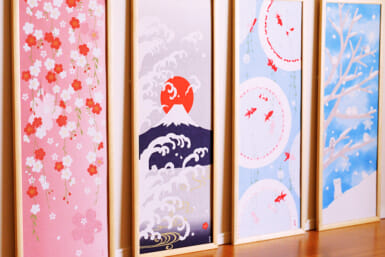The omnipresent arguments between parents and kids regarding food and eating go back for generations. For non-Japanese eating in Tokyo, however, sometimes the restaurant choices and menus can be quite a challenge.
The lucky thing about living and eating in Japan is that most Japanese restaurants welcome children. The staff is often excited that Westerners, in particular, are interested in trying the food, and waiters look to please their customers in any way possible. My kids, Bailey, age 11 and Sydney, age 8, have learned to experiment with eating and the various cuisines open to them. They didn’t start out that way, however; their attitudes developed over time.
Ideally, one should introduce kids to the ins and outs of Japanese eating slowly. One fun place to eat is Sushi To Dai For in Azabu Juban. Opened in late December 2009, the restaurant originated in California, so the tastes are a mixture of Japanese ingredients and presentation with a Californian flair. For example, my kids enjoy a roll called the ‘mojo-jo-jo,’ which is named after an American cartoon character. It contains fish, but the roll itself is fried and has yummy crunchies all around the plate and on top of it. Another roll we enjoy is the ‘Darth Vader,’ which also has a hint of fish, but enough sauce and rice and nori to hide the healthy stuff so the kids will enjoy the experience. Our family enjoys sitting up at the sushi bar so the kids can watch their meal being prepared. The owner and chef enjoys bantering with the kids, which makes them feel special. With a little prodding and encouragement from their parents and the chef, my children have been able to branch out from the non-traditional California- type sushi to the more traditionally Japanese menu offerings.
Parenting Tips:
Getting Kids to Bite
1. Tell kids that you’re on an adventure—an eating adventure—and that trying new foods is part of the fun.
2. Pick foods that resemble things your kids already eat; start with milder flavors first.
3. Sauces and foods that are mixed together sometimes make kids nervous, so try to order things that appeal to the kids’ eyes as well as palates.
4. Pick restaurants that interest both parents and kids so everyone is happy!
5. If at first you don’t succeed, keep trying! Don’t give up just because your kids won’t eat at one place. Pick another spot and give it another go.
6. Maturity counts, so if you start the kids young, they’ll be used to trying new things by the time they’re older.
The best part about Sushi to Dai For is that it caters beautifully to the adults as well. There are traditional maki rolls, but also sashimi and nigiri as well. The restaurant also boasts a full bar and is open late.
Another great choice with kids is the ever-present tempura. Our favorite is Mikawa, with its smaller restaurant branch in Roppongi Hills, across the plaza from Enoteca and above the Mini dealer. There are about a dozen seats at the bar and then two small tatami-floored tables. Mikawa is a family-owned and run business, so they treat everyone who enters as a member of that family. The mama-san, who greets guests and serves, loves when we bring the children into her restaurant. There is a traditional, seasonal omakase menu that is big enough for the kids to easily share. This is another place where the kids love watching the chef from the counter as he clicks his long, wooden cooking chopsticks together before picking the tasty morsels out of the sizzling wok full of oil that boils on the lowest heat possible to cook the food. I am not sure how it happens, but at Mikawa, somehow the tempura ends up tasting light. There is not a bit of grease falling off the food and there is no heaviness in the belly after the meal.
The kids love watching the chef from the counter as he clicks his long, wooden cooking chopsticks together before picking the tasty morsels out of the sizzling wok.
Chinese food is always a good option with kids, but some of the places that kids prefer for the plainer fare don’t always appeal to the adults who bring them there. Our favorite Chinese restaurant is called Hutong of Beijing, and it’s located at the bottom of Keyakizaka near Roppongi Hills. The charm of this particular restaurant is that the sauce of every dish is different. The kids are introduced to many seemingly authentic different tastes all in one place. For example, the sweet and sour pork is not fried, but broiled until it’s so tender that it falls apart with a fork, and served with a thick, dark hoisin sauce that the kids love. The fried rice has little to no oil in it, and the steamed gyoza have a hint of leek flavoring that we all enjoy. Hutong of Beijing has a particularly casual atmosphere with its wooden floors and chopsticks right on the table, so the kids feel freer than in other places to which we take them. I don’t worry if they make a little noise or bring out their drawing pads to put on the table as the adults finish their meals. Between the food and the surroundings,it’s a place the whole family enjoys.
Eating out ethnically in Tokyo with children does not have to be a trial. The trick is to find places that are kid-friendly but also cater to adult needs. The usual fast food or pasta joints are always available, but if you want to appeal to everyone in the family, keep your eyes open foroptions that abound around you.
photo by Joe Lewis









